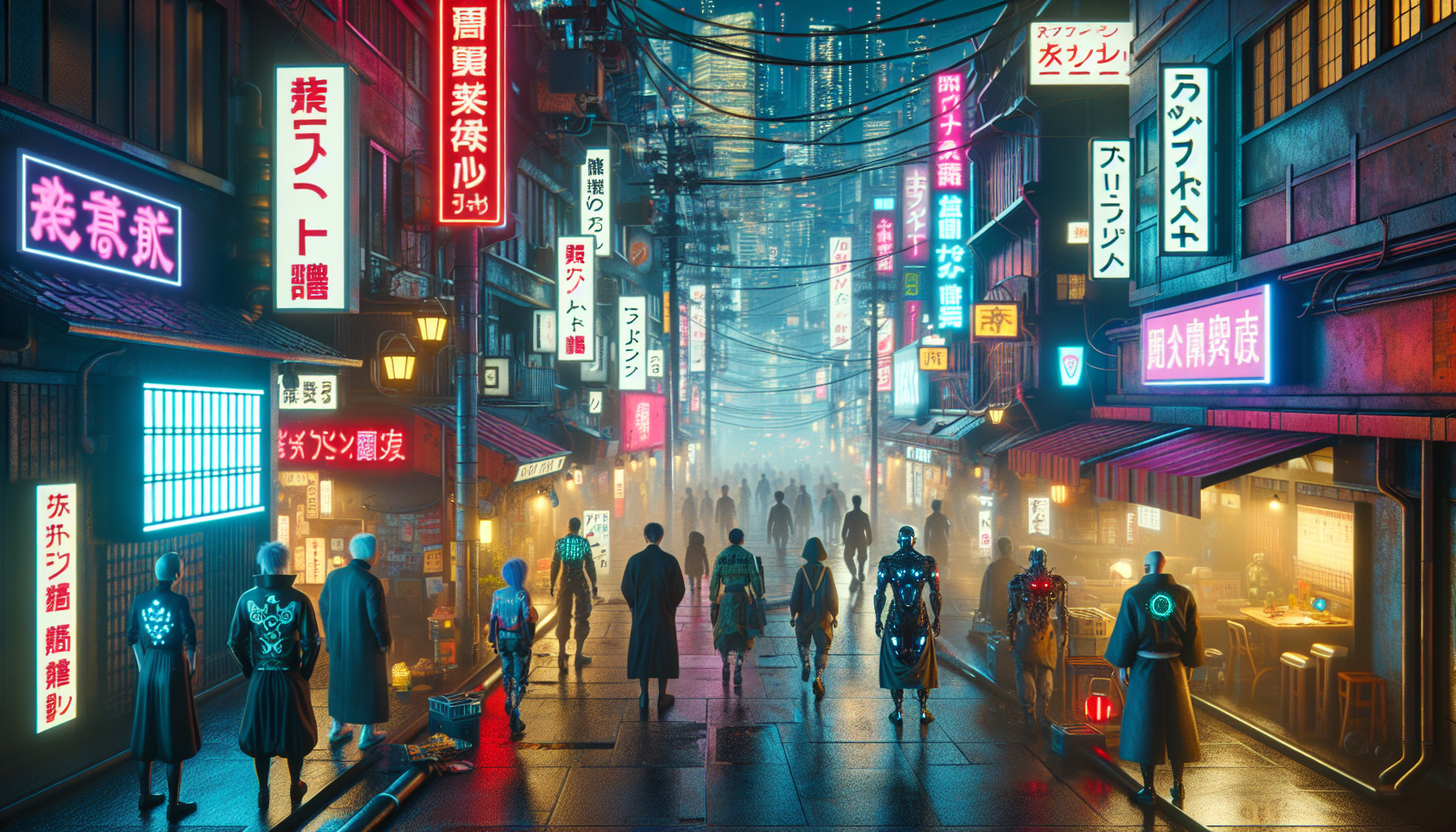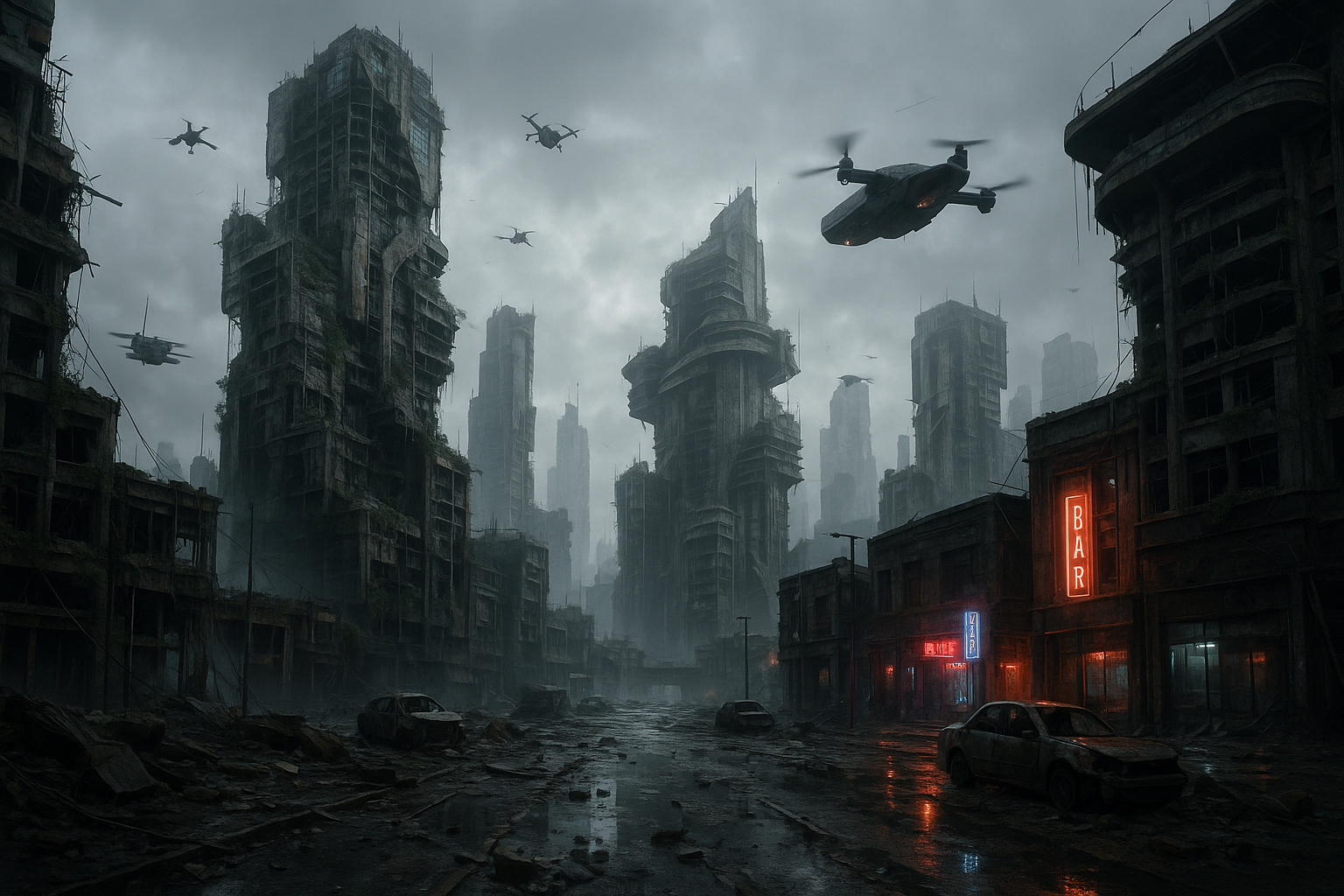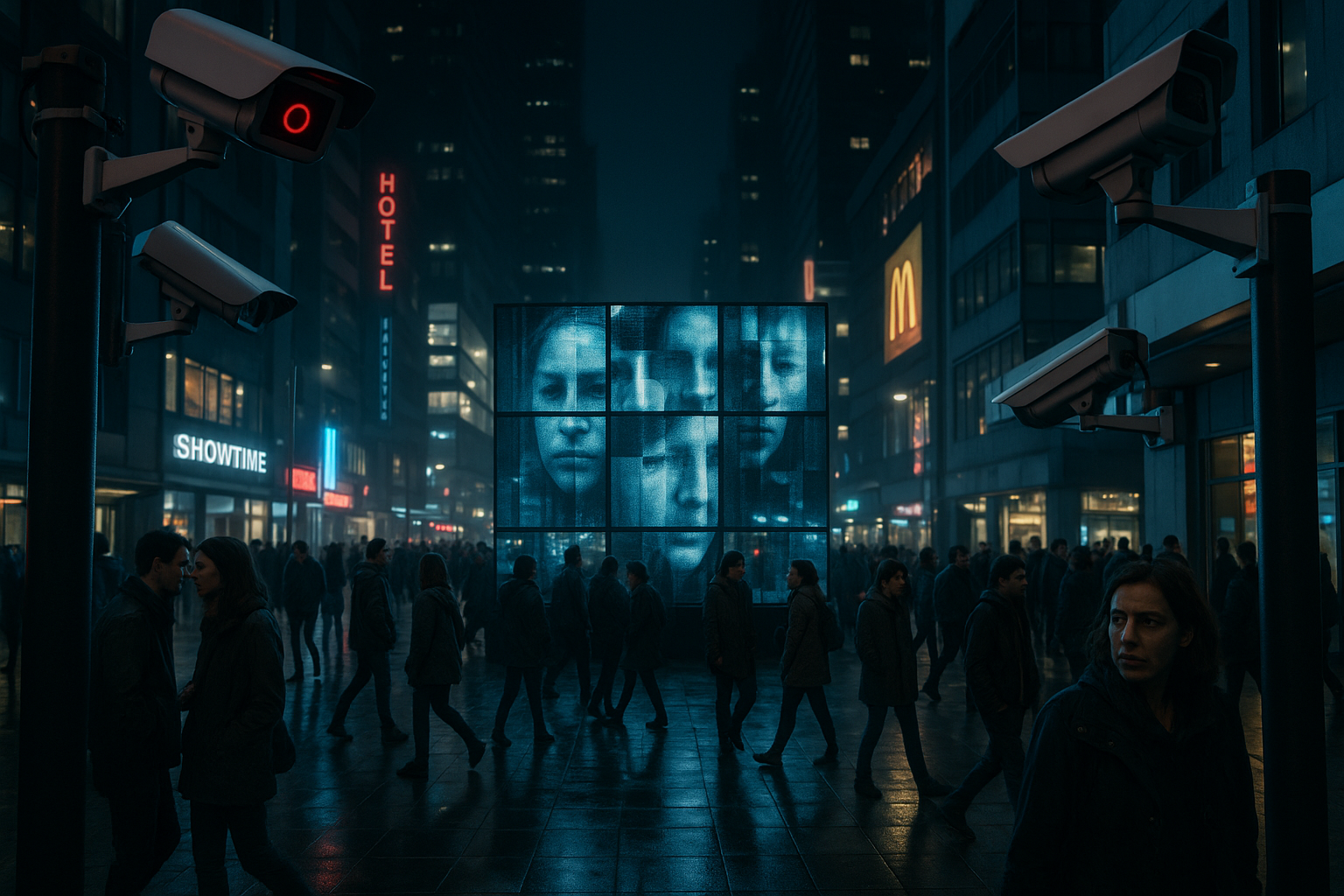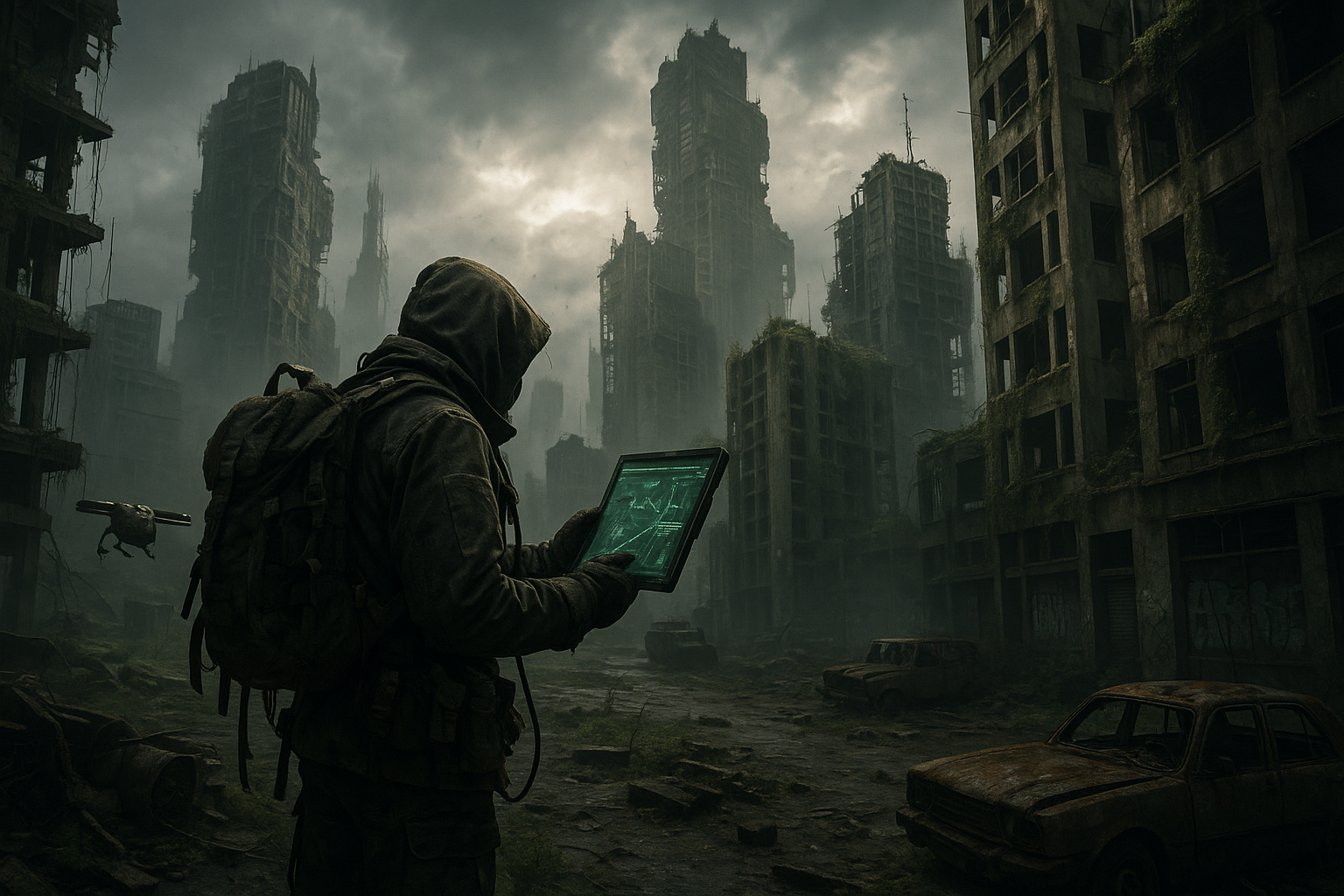Anúncios
In a world where the boundaries between the virtual and the real are increasingly blurred, the aesthetic of cyberpunk stands out as a vivid tapestry woven from the threads of technology, dystopia, and cultural hybridity. Originating as a subgenre of science fiction in the early 1980s, cyberpunk has transcended its literary roots to become a global cultural phenomenon, influencing everything from fashion to video games, and even architecture. At the heart of this stylistic and thematic evolution lies an intricate and compelling relationship with Japanese culture. From neon-lit cityscapes reminiscent of Tokyo’s Shibuya and Shinjuku districts to philosophical underpinnings inspired by Shinto and Zen, Japan’s impact on cyberpunk aesthetics is profound and multifaceted. 🌆
Anúncios
This article embarks on a journey from the bustling streets of Tokyo to the sprawling realms of cyberspace, exploring how Japanese culture has shaped the cyberpunk narrative and aesthetic. We delve into the historical context of Japan’s post-war economic boom, a period that saw the country rise from the ashes of conflict to become a symbol of technological prowess and futuristic urban development. This era not only provided a fertile ground for cyberpunk creators but also birthed a unique cultural milieu where tradition coexisted with cutting-edge innovation. How did Japan’s rapid industrialization and urbanization feed into the dystopian visions of cyberpunk worlds? And in what ways did traditional Japanese philosophies and art forms contribute to the genre’s rich tapestry?
Anúncios
As we navigate through the digital and analog landscapes, we’ll uncover the visual and thematic symbiosis between Japanese cityscapes and cyberpunk settings. Cities like Tokyo, with their towering skyscrapers, bustling crowds, and neon-drenched streets, have become the quintessential backdrop for cyberpunk narratives. These urban environments, characterized by their blend of the old and new, offer a striking contrast that highlights the genre’s exploration of duality—technology versus nature, progress versus decay. We’ll examine iconic films such as “Blade Runner” and “Akira,” which have not only borrowed heavily from Japanese imagery but also paved the way for a global fascination with these dystopian visions.
Moreover, we’ll explore the philosophical dimensions of cyberpunk that draw heavily from Japanese thought. The genre frequently grapples with questions of identity, consciousness, and the human condition, themes deeply rooted in Buddhist and Shinto beliefs. Concepts like the interconnectedness of all things and the transient nature of existence resonate within cyberpunk’s exploration of artificial intelligence, virtual realities, and the cyborg experience. How do these philosophies shape the narratives and characters within the genre, and what does this say about our relationship with technology and the self?
Finally, we’ll consider the cultural exchange that continues to influence both Japan and the cyberpunk genre today. As Japanese creators take the helm in producing cyberpunk works, from manga and anime to video games, they infuse the genre with new perspectives and narratives, reflecting their own cultural nuances and technological anxieties. This ongoing dialogue between Japan and the global cyberpunk community not only enriches the genre but also reflects broader trends in globalization and cultural hybridization. What does the future hold for cyberpunk as it continues to evolve alongside technological advancements and cultural shifts?
Join us as we unravel the complex tapestry of Japanese influence on cyberpunk aesthetics, a journey that promises to illuminate the genre’s past, present, and future. Whether you’re a seasoned cyberpunk enthusiast or a curious newcomer, this exploration offers valuable insights into how a nation steeped in tradition and driven by innovation has left an indelible mark on one of the most compelling and visually arresting genres of our time. 🌐
The Genesis of Cyberpunk: Roots in Japanese Culture
Cyberpunk, a subgenre of science fiction, is known for its gritty portrayal of a dystopian future where technology and human society are intimately interwoven. Its origins can be traced back to the late 20th century, a time when rapid technological advancements began to reshape societies globally. However, Japan’s influence on cyberpunk aesthetics cannot be understated. The nation’s unique blend of tradition and technological innovation has profoundly shaped the visual and narrative frameworks of cyberpunk, leading to a genre that feels both futuristic and grounded in cultural reality.
In Japan, the post-war economic boom led to unprecedented technological progress, particularly in electronics and robotics. As cities like Tokyo rapidly modernized, they became emblematic of a hyper-technological urban landscape, brimming with neon lights, skyscrapers, and a blend of modern and traditional architecture. These real-world developments in Japan provided a fertile ground for cyberpunk’s narrative seeds, which often portray sprawling megacities as both technologically advanced and socially complex.
Moreover, Japanese culture’s inherent appreciation for both nature and technology creates a duality that is central to cyberpunk storytelling. This duality is reflected in the contrast between the organic and the synthetic, a theme prevalent in many Japanese-inspired cyberpunk narratives. For instance, the juxtaposition of nature and machine in anime films like “Ghost in the Shell” underscores a philosophical exploration of humanity’s place in a tech-dominated world. As you delve deeper into the world of cyberpunk, it’s fascinating to see how Japanese culture continues to influence this genre’s aesthetics and narratives. 🌟
Table: Key Elements of Cyberpunk vs. Traditional Japanese Culture
| Cyberpunk Element | Influence from Japanese Culture |
|---|---|
| Neon-lit Cities | Inspired by Tokyo’s Shibuya and Shinjuku districts |
| Technological Advancements | Reflects Japan’s leadership in electronics and robotics |
| Cybernetic Organisms | Echoes themes in Shinto beliefs about animism |
For a visual exploration, check out this insightful video that discusses Japan’s impact on cyberpunk aesthetics: The Influence of Japan on Cyberpunk by TechCulture Channel. 🎥
The Rise of Anime and Manga: Shaping Cyberpunk’s Visual Language
The role of anime and manga in shaping cyberpunk’s visual aesthetics is both profound and undeniable. Japanese animation and graphic novels have long explored themes of technology, identity, and dystopian futures, making them a natural fit for the cyberpunk genre. Iconic works like “Akira” and “Ghost in the Shell” are pivotal examples that have not only influenced Western cyberpunk but have also defined its visual and thematic vocabulary.
“Akira,” released in 1988, is often credited with bringing Japanese anime to global audiences. Set in a post-apocalyptic Tokyo, the film’s depiction of a technologically advanced yet socially decayed cityscape became a template for cyberpunk’s visual settings. The film explores themes of political corruption, unchecked technological growth, and societal breakdown—all central to cyberpunk narratives. The dynamic animation style, combined with a complex, layered storyline, captivated audiences and demonstrated anime’s potential to convey deep, mature themes.
Similarly, “Ghost in the Shell” delves into the intersection of technology and identity, questioning what it means to be human in a world where consciousness can exist outside a physical body. This philosophical inquiry into the nature of self is a hallmark of cyberpunk, and the film’s breathtaking animation set a standard for visual storytelling. The intricate details of its futuristic cityscapes and the sophisticated portrayal of its cybernetic characters highlight the distinctive aesthetic that Japanese anime brings to cyberpunk.
Anime and Manga: Contributions to Cyberpunk
- Exploration of dystopian futures and societal issues
- Integration of philosophical questions about identity and humanity
- Innovative animation styles and storytelling techniques
To further explore these influences, watch this engaging analysis of cyberpunk anime on YouTube: “Cyberpunk’s Anime Revolution” by Cinema Corner. 📽️
Technological Themes: Japan’s Futuristic Yet Traditional Narrative
Japan’s intricate balance of the futuristic and the traditional is a recurring theme within cyberpunk literature and film. This theme manifests in the portrayal of a world where cutting-edge technology coexists with deeply rooted cultural practices. The presence of traditional elements within a high-tech world provides a unique narrative tension that is both fascinating and thought-provoking.
In Japanese society, the reverence for tradition and history is evident even amidst rapid technological innovation. This cultural characteristic is mirrored in cyberpunk narratives that juxtapose ancient customs with futuristic technology. For instance, the presence of temples and shrines nestled within sprawling megacities serves as a constant reminder of the past in a future world. Such settings evoke a sense of nostalgia and continuity, even as they highlight the potential dissonance between progress and heritage.
Moreover, Japanese cyberpunk often explores the philosophical implications of technology on identity and society. Themes of transhumanism, where humans integrate with machines, are frequently examined through a cultural lens that questions the nature of the soul and consciousness. In works like “Neon Genesis Evangelion,” the fusion of human and machine becomes a metaphor for deeper existential inquiries, rooted in Japan’s spiritual and philosophical traditions.
Comparison of Cyberpunk Themes: Western vs. Japanese
| Western Cyberpunk | Japanese Cyberpunk |
|---|---|
| Focus on corporate dystopia | Blend of technology and spirituality |
| Individual vs. system narratives | Existential and philosophical themes |
| Technological determinism | Balance between tradition and innovation |
For a deeper dive into these themes, view the following insightful video on the philosophical aspects of cyberpunk: Cyberpunk: Philosophy and Culture by Mind Matters. 🌐

Conclusion
As we draw to a close on this exploration of the profound impact of Japanese culture on cyberpunk aesthetics, it’s clear that the journey from Tokyo’s bustling streets to the limitless expanses of cyberspace is as vibrant and complex as the themes themselves. Throughout this article, we have traversed the intricate layers of how Japanese cultural elements have interwoven with the fabric of cyberpunk, creating a rich tapestry that continues to inspire and captivate.
Firstly, we examined the foundational elements of cyberpunk—a genre that emerged in the late 20th century, characterized by its focus on high-tech, low-life dichotomies, and dystopian futures. We discussed how Japanese culture, with its unique blend of tradition and modernity, seamlessly integrates into this framework. Tokyo, as a symbol of cutting-edge technology juxtaposed with deeply rooted cultural heritage, serves as an ideal muse for cyberpunk creators. The neon-lit streets of Shibuya and Shinjuku, bustling with activity and technological marvels, echo the chaotic and vibrant environments depicted in seminal works like “Blade Runner” and “Akira.”
Next, we delved into specific cultural influences, such as the aesthetic of wabi-sabi—an appreciation of imperfection and transience—that resonates deeply within cyberpunk’s gritty, imperfect worlds. This concept challenges the conventional pursuit of perfection, highlighting the beauty in decay and impermanence, elements that are often central to cyberpunk narratives.
Moreover, we discussed the significant impact of Japanese pop culture, particularly anime and manga, on the cyberpunk genre. Series like “Ghost in the Shell” and “Neon Genesis Evangelion” have not only defined but also expanded the genre, introducing philosophical questions about identity, consciousness, and humanity’s relationship with technology. These narratives offer profound insights into the potential futures of our own society, serving as both cautionary tales and sources of inspiration.
Another critical aspect we explored is the influence of Japanese mythology and spirituality in cyberpunk storytelling. Shinto and Buddhist elements frequently appear in cyberpunk, providing a spiritual counterbalance to the genre’s often bleak technological landscapes. This integration of spirituality encourages viewers and readers to ponder the soul’s place in an increasingly digital world.
Importantly, the article also highlighted the reciprocal relationship between Japanese culture and cyberpunk. As much as Japan has shaped the genre, the genre has, in turn, influenced Japanese society and media, creating a dynamic and ongoing exchange. This cultural interplay has led to innovative artistic expressions and technological advancements, further blurring the lines between reality and the cybernetic future envisioned by cyberpunk creators.
The relevance of this topic extends beyond mere academic interest or fandom enthusiasm. Understanding the interplay between Japanese culture and cyberpunk aesthetics provides valuable insights into how cultures influence and inspire one another. In our globalized world, this awareness fosters cross-cultural appreciation and understanding, paving the way for more inclusive and diverse narratives in media and beyond.
As you reflect on the themes discussed, consider the implications of these cultural exchanges and their influence on contemporary art and technology. How might these narratives shape our understanding of identity, technology, and society? What lessons can we learn from the dystopian futures depicted in cyberpunk that might help us navigate our present?
We encourage you to engage with this topic further. Share your thoughts and insights with others, either through discussions or by sharing this article. Your perspective adds to the richness of the conversation, helping to shape the future of how we understand and interpret these complex themes.
Finally, we invite you to explore the world of cyberpunk and Japanese culture more deeply. Whether through watching classic films, reading influential manga, or even experiencing Tokyo’s vibrant cityscape firsthand, there is much to discover and learn. In doing so, you contribute to the ongoing dialogue between cultures, adding your voice to a conversation that is as dynamic and evolving as the world it describes.
🔗 For further reading and exploration, consider these resources:
– [The Influence of Japanese Culture on Cyberpunk](https://www.cyberpunkculture.com) (please verify current status of link)
– [Understanding Wabi-Sabi in Modern Design](https://www.japanesestudies.org) (please verify current status of link)
Thank you for embarking on this journey with us. May your continued exploration of cyberpunk and Japanese culture be as inspiring and enlightening as the themes we’ve discussed. 🌟
Toni Santos is a visual storyteller and artisan whose work reimagines fashion in the aftermath of civilization. Exploring the aesthetics of survival, decay, and resilience, Toni crafts wearable narratives shaped by a post-human world — where utility meets myth, and remnants become ritual.
Drawn to the raw beauty of collapse and adaptation, Toni’s creations emerge from imagined futures and forgotten pasts. Torn fabrics, corroded metals, and salvaged textures form the foundation of a style that speaks not just to what is worn — but to what has endured. Each piece tells a story of transformation, of identity reshaped by ruins and time.
Through garments, accessories, and visual compositions, Toni constructs a language of dress where fashion is not decoration but declaration — a symbol of survival, memory, and the human spirit persisting in desolation. With a background in visual design and handcrafted techniques, Toni blends precision with provocation. His works are tactile philosophies, designed to be worn, felt, and remembered.
As the creative voice behind Vizevex, Toni shares a vision of fashion as post-civilization mythology — offering curated collections and visual essays that explore the line between relic and garment, artifact and identity.
His work is a tribute to:
The resilience encoded in fabric and form
The symbolic armor we craft in the face of extinction
The beauty found in fragmentation, rust, and reassembly
Whether you are an artist, a futurist, or someone drawn to the aesthetics of survival and reinvention, Toni invites you into a world where fashion becomes memory — one stitch, one scar, one future at a time.





